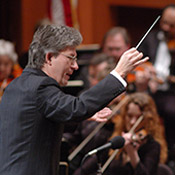
MSO Archive Finds Its Home
David Lewellen
PUBLISHED
Tagged Under: 2023.24 Season, Bradley Symphony Center, MSO Notable
Several floors above the glamorous Art Deco finish of Allen-Bradley Hall, the floors are linoleum and the walls are raw plaster. But among the important work happening here is the creation of a working, accessible archive of the Milwaukee Symphony’s history.
The work has fallen to David Jensen, who started 10 months ago as the symphony’s marketing and communications coordinator. Although he had library experience, the archive was not part of his job description when he was hired last year. “It was the best surprise I got,” he says. “It’s like a dream come true. I don’t know if anyone had a sense of how deep this could go.”
The first stage was mostly sorting through banker’s boxes full of unorganized papers, CDs, and tapes. In past decades, the MSO Women’s League and MSO’s administrative staff would keep careful scrapbooks of concerts, galas, and other activities, but that ended in the late 1990s. Jensen began sorting programs, marketing materials, loose photos, and more, trying to organize them and note what was missing. Retired musicians have filled in some gaps, he says, and appeals to the community for old materials are also paying off.
The task becomes even more complicated with the early 2000s, when more materials began moving to various electronic formats. Jensen is working to build robust internal Excel spreadsheets, with metadata tags to identify all of the people in a photo (for instance) and the year and place it was taken, in order to build searchable databases.
The project has waited this long, in part, because the MSO never had a space of its own, according to Communications Director Erin Kogler. It would have been even harder to build an archive in rented office space, she said, but “once we had a permanent home, we needed to get our archival materials into a place where we could really utilize them.”
Kogler realized the magnitude of the task when she was working on past special projects such as the MSO’s 50th anniversary book in 2009 and a PBS special in 2021. She remembers “digging through boxes of loose photos, trying to find things they were asking for.” Aside from Jensen’s experience, she said, he “was interested, and that’s half the battle, because it’s a lot of work.”
She sees the archive as a communications tool, to be available to the public eventually. It could be used for articles and displays on the orchestra’s history, “where we’ve come from and where we’re going.”
For electronic records in particular, format migration is a challenge. “We are walking up a hill of sand,” Jensen says. “At some point, everything will disintegrate.” Digitizing audio and VHS tapes is on the future to-do list, but it will be a slow and expensive job. However, the MSO’s in-house recording engineer, Jeremy Tusz, already maintains up-to-date and backed-up archives of everything from the digital era.
Storing records in the cloud carries its own risk, but Jensen points out that all of the physical records could be lost in a disaster, too. “The cloud is an important resource, a tool,” he says. “But it can’t ever be the whole story.”
The archive will never be a finished product, but it is getting closer to being a publicly available resource. Archivists at other major orchestras have been generous with time and advice, Jensen says, and he also credits the help of Russell Star-Lack, an intern from UW-Milwaukee’s School of Information Studies.
As papers are sorted and classified, they go into acid-free folders and boxes for preservation, and Jensen is working on a searchable finding list for physical and digital materials. “The goal is to have photographs that are keyword-searchable,” he says. “It’s kind of like building Google Images. I’m not a computer scientist, but it’s possible.”
On a quick tour of the space that the new archive shares with the MSO’s music library, Jensen points out some scrapbooks filled with yellowed newsprint. “So many things are disintegrating,” he says. The material should be scanned at some point, but large, high-quality scanners are expensive.
Against one wall, a pile of seven boxes is all that is left of the unorganized material he inherited. “We’ve come a long way,” he says. “But it’s not just going from A to Z and thinking you’re done. There are new things all the time.”
“We put it off and put it off,” Kogler says, “but now it’s nice to have our own home and our own space to put things.”



